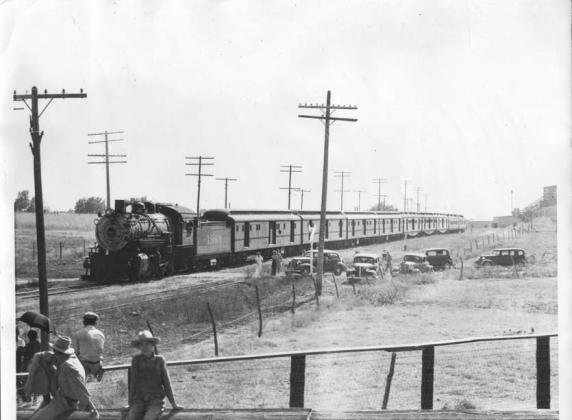Dublin had the cowboy culture and all the character of the old west in it’s early days. During that time, the Old Cora Trail came right through Dublin as cattle were herded through the streets of Dublin on their way towards Cleburne.
The Old Cora Trail was mapped out by John Chesley Gilbreath shortly before his death in 1894. His new route enabled the cattle to be moved with the least number of creek crossings along the way. That cattle trail became the FM 1702 highway we know today that goes through Edna Hill.
The Old Cora Cattle Trail itself, started in Cora, a creek crossing in Comanche County where the South Leon River and Deep Creek met. Back at the turn of the century there must have been lush grasses along the South Leon River. In that area there were several creeks that fed the river. It must have been a good area to raise cattle. The Cora trail went through Hazel Dell, Edna Hill, then Dublin on the way to join other cattle trails south of Fort Worth. As the cattle were herded along the trail, moving them 10 miles per day was a full day’s work. So it was about a 10 mile journey from Cora, to Hazel Dell, to Edna Hill then Dublin.
The Cora Cattle Trail was called a feeder trail. It joined other trails that eventually, fed into the Chisholm Trail. The larger Chisholm Trail was formed just West of Fort Worth and continued from there to the meat plants in Kansas City and Chicago. In those early days there was still open range around Dublin. The fencing of property hadn’t started. That enabled the herds of up to 2500 cattle to be rounded up and moved on their way with no fences getting in the way.
The drive would consist of a trail boss and up to 20 cowhands. The trail boss would charge $1 per head of cattle to take them to market. At the sale, cattle could fetch $20. Those who didn’t have the money to pay up front, could have the $1 fee taken out when the cattle sold. After the business dealings were done, the trail boss would come back and pay the owners what they were owed. Large ranches such as the King Ranch in south Texas would have 2500 cattle alone. But, most of the ranches close to Dublin were not that large, so the drives here were made up of cattle from a number of ranches each sending the cattle they had.
As time passed, more land was being fenced in to prevent the cattle from eating or trampling farmer’s crops. By 1890 the arrival of railroads and the fencing of land brought an end to the big trail drives. That was not without the struggles between farmers protecting their farms and ranchers who needed grazing land.
With the Fort Worth and Rio Grand railroad coming here, Dublin became a railhead of sorts. Dublin enabled cattle raisers to send their cattle to market by train instead of herding them all the way to Fort Worth. Once on the train, the cattle could be taken anywhere they could get best price. (Oral History, Harrell Gilbreath) A. A. Hartgrove, was a wealthy man came to Dublin about 1890 and dealt with land and cattle. He married Miss Cora McKinnie who taught school in Dublin. He ended up building the Dublin Oil Mill now known as the Dublin Peanut Mill. He fed out thousands of steers each year. He built extensive cattle pens at the railroad tracks near the Dublin football field on Harris Street. (Grand Ol’ Erath, H. G. Perry, p189) A Dublin Progress 1903 article, states that Winfield Scott (a local man) had gotten permission from the Dublin Cotton Oil Company who owned the pens, to use them exclusively. The Progress article stated that anyone else who wanted to feed or water cattle there would be prosecuted.
The pens themselves were later used by the World Championship Rodeo, shipping rodeo live stock to New York for the Madison Square Garden Rodeo and other destinations.
And so the cowboy culture was alive well before the turn of the century. It was only natural when Everett Colburn came here with his cattle, that the rodeo spirit fit with Dublin and it’s cowboy culture.
Many thanks to Harrell Gilbreath for his insight and information on this little known aspect of Dublin History.


